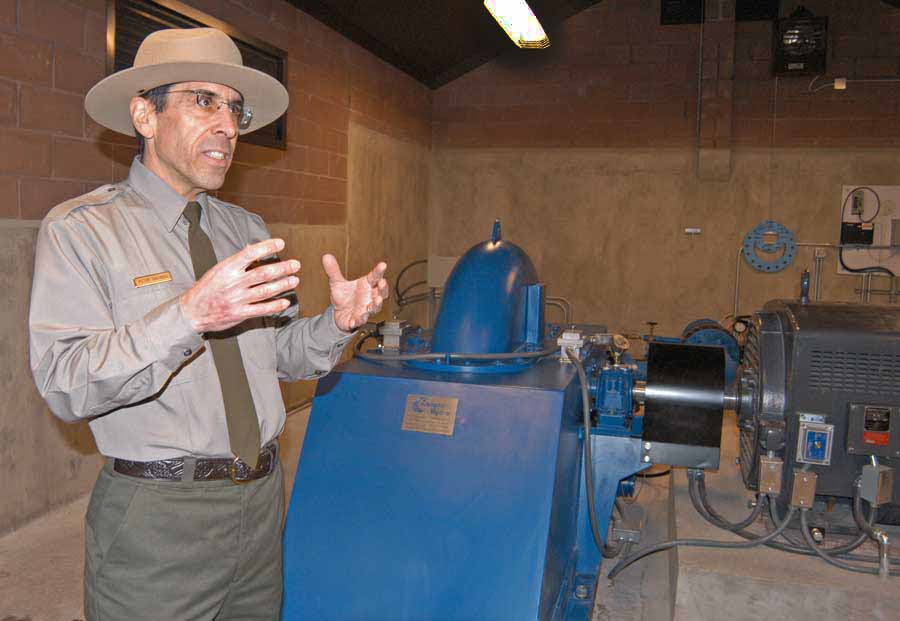
Peter Galindo, a project engineer for Yellowstone National Park, discusses a new small-scale hydro-electric power system now in use near Mammoth Hot Springs. (Ruffin Prevost/Yellowstone Gate - click to enlarge)
By Ruffin Prevost
MAMMOTH HOT SPRINGS, WYO. — For centuries, various waters and thermal features across Yellowstone National Park have spouted steam, sulfur and silica during countless eruptions. Now, one stream in the park is emitting dimes.
At least that’s how Yellowstone project engineer Peter Galindo saw it Wednesday, as park officials showed off a new hydro-electric power system that is expected to save the National Park Service at least $73,000 annually in electricity costs.
“I just think of this thing as spitting out a dime every minute or so,” Galindo said with a smile, gesturing as if he were plucking an imaginary coin from the air. “Oh, there’s another dime.”
Completed in October and brought online last month, the $1.1 million power plant taps into an existing 12-inch water main about a half-mile north of Mammoth, capturing the energy of water as it travels more than 500 feet downhill from Swan Lake Flats.
About the size of a two-car garage, the power plant building is located far from public view in the woods beside a settling pond where water diverted from the Gardner River, Panther Creek and Indian Creek are treated for use as drinking water in Mammoth hotel rooms, restaurants, staff housing and public buildings.
Deputy Superintendent Steve Iobst said the system relies only on water already diverted for treatment as drinking water, and that it will operate reliably around the clock for decades, with only a few days of downtime each year for routine inspections.
Based on projected trends in electric power rates, the system could pay for itself within about 12 years, Galindo said. That amounts to approximately a dime’s worth of savings about every 40 seconds.
Stimulus funding
That projected savings and payback helped secure stimulus funding for the project under the 2009 Recovery Act. Work was done by Dick Anderson Construction of Bozeman, Mont., with project design and supervision by CTA of Billings, Mont. According to documents filed at recovery.gov to track stimulus spending, between 2-4 full-time jobs were created or preserved for most quarterly reporting periods when work progressed.
“It was really the right project at the right time,” Galindo said.
In fact, it had been a project park officials wanted to do since the mid-1980s, Iobst said, but funding had never been available before.
Small-scale “micro-hydro” power makes perfect sense in Mammoth, something U.S. Army engineers realized in 1903 when they installed a 100-kilowatt turbine to provide electricity to Fort Yellowstone when no commercial power plants existed in the area.
Mammoth continued to use hydro-electric power until 1966, when commercial power was abundant and cheap, Iobst said.
No additional employees are needed to work on the new system, and annual operating costs are well under $5,000, Iobst said.
“It’s very low maintenance,” said Ralph Jerla, who oversees drinking water treatment for Mammoth. Jerla checks on the system for a few minutes each day, monitoring water flow and temperature. He lubricates the bearings when necessary, a simple procedure that doesn’t require shutting down.
The new system ties directly into the regional power grid, providing a maximum of 230 kilowatts per hour, but averaging about 175 kilowatts per hour. That’s enough to cover about one-third of the staff housing and administrative power use (excluding concessions-related needs) in Mammoth, reducing the park’s carbon dioxide emissions by more than 700 tons per year. In keeping with an agency-wide initiative, Yellowstone has set a goal to cut greenhouse gas emissions by 15 percent by 2016, the Park Service’s centennial year.
Complex negotiations
One reason the project took longer than planned, Iobst said, was because Park Service managers were negotiating more than 30 other grid-connected projects nationwide over the last couple of years.
Negotiations with power provider Northwestern Energy were also complex and time-consuming, Iobst said, because no state public utilities commission oversees how the Montana provider delivers electricity to the Wyoming community of Mammoth.
That meant operating in a regulatory and legal limbo that required starting from scratch, but that yielded what Galindo said was “a good deal for the Park Service,” which is credited at the default provider rate for all power produced.
Because the system requires incoming electricity for initial start-up, it can’t be used to provide emergency power to Mammoth in the event of a grid outage, Galindo said.
Iobst said the system is fairly simple, using the same basic Pelton-wheel design as employed in the original hydro-electric generator installed at Mammoth in 1903.
Negotiations for that original project were also complex, requiring an act of Congress to allow Yellowstone to sell excess power for private use, according to an unpublished account by Yellowstone historian Lee Whittlesey.
In 1911, the Army completed a new power house that still stands today in lower Mammoth, but is no longer in use. The total cost for that project was $45,889, or adjusted for inflation, approximately $1.1 million in today’s dollars.
Contact Ruffin Prevost at 307-213-9818 or ruffin@yellowstonegate.com.

What percentage of consumption does the $73,000 represent for purpose of a cost benefit analysis? In other words, couldn’t the savings be achieved through voluntary reduction in consumption? For example, at Christmas 2008, lights on the Christmas tree proximal to the superintendent’s house and office were left on until February 1, 2009.
With so much emphasis placed on reducing carbon emissions, such as listed in this article with a reference to hydro plant’s contribution to emission reduction, the NPS should have a standing policy of no idling vehicle engines for longer than thirty seconds and implement a strict car pooling policy.